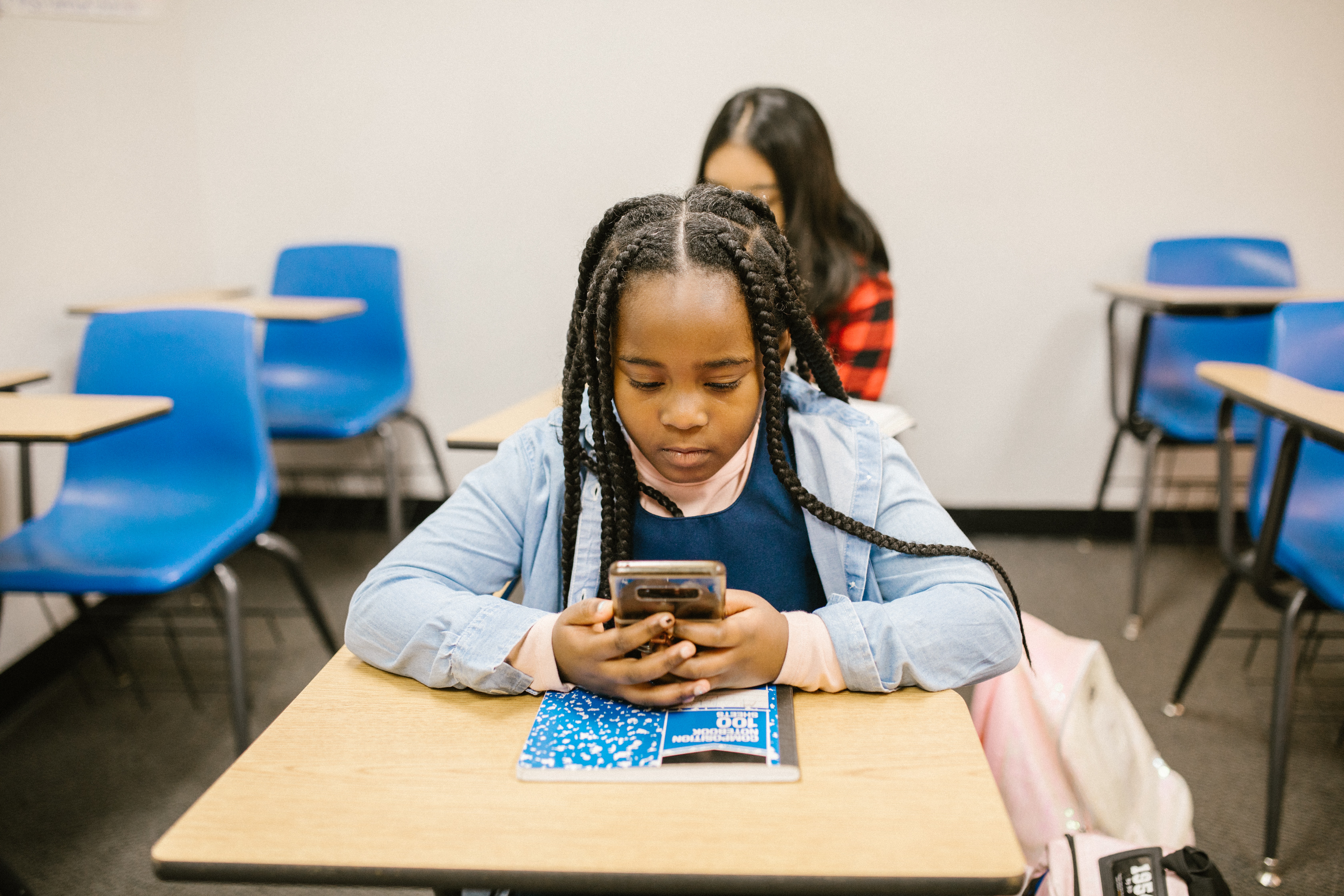7 Tips to Encourage Mindful + Productive Cellphone Use
Cellphones have become an inseparable part of daily life for many, if not most, of today’s students. From staying connected with peers to accessing information and scheduling events, these devices play a critical role in modern life. However, as educators, we are faced with the reality that phones can also distract from learning and open the door for undesirable behavior with potentially long-term consequences. We are challenged to guide students to use their phones in ways that promote well-being, learning, and healthy relationships with their peers and the online communities they may engage with.
Wayfinder is committed to helping students craft lives of belonging and purpose. With cellphones being such an inextricable part of their lives, part of this mission means teaching young people how to navigate the digital world mindfully. While schools, districts, and families ultimately determine the policies surrounding students’ cellphone use, Wayfinder can offer our best insights and resources for teaching digital citizenship and discernment.
The Reality of Cellphone Use in Schools
Cellphones are an unavoidable and often-discussed reality in K-12 schools. A 2019 Pew Research Center report found that 95% of teenagers had access to a smartphone, and nearly 45% of them reported being online “almost constantly.” This level of connectivity can have profound effects on students' academic performance, mental health, and social relationships.
Research highlights the double-edged sword that phones present. On one hand, they offer access to educational resources, enable communication, and foster social connections. On the other, excessive and/or irresponsible use, especially during school hours, has been linked to distractions in class, cyberbullying, and increased anxiety and depression. As such, it is crucial for educators to strike a balance—acknowledging the benefits of cellphones while also addressing the potential risks.
Encouraging Positive Digital Habits
At Wayfinder, we believe that the only long-term solution in a world where cellphones aren’t disappearing is teaching students how to use them responsibly. Lessons and activities throughout our curriculum help students develop digital discernment, a critical skill that empowers them to navigate the online world with awareness and intention. By integrating lessons on digital literacy, empathy, and self-reflection, we aim to support educators in fostering positive cellphone behaviors among students.The following are a few ways Wayfinder supports educators in encouraging healthy digital habits. Try some at your school to make a positive impact on the mindsets and behaviors that shape students’ online lives.
- Tracking and Reflecting on Screen Time
It may seem obvious, but one of the first steps to promoting mindful cellphone use is helping students become more aware of their screen time. Despite automated screen time reports, many students are unaware of how the time they spend on their devices impacts their daily lives, productivity, and progress toward personal goals. Encouraging students to actively reflect on the opportunity costs their screen time entails can serve as a wake-up call and provide a foundation for discussions about how they spend their time on and offline.
Screen time reflections can be incorporated into lessons as part of advisory, health, or wherever else students are actively learning and practicing interpersonal and life skills. Ask students to track their screen time for a week and then discuss the results as a class. What surprised them? How did their screen time impact their mood, sleep, or productivity? Use reflection time as an opportunity to talk about the importance of setting healthy boundaries with technology and using it in a way that promotes overall well-being. - Observing Digital Presence
Another key aspect of mindful cellphone use is understanding one’s presence on social media. Students often curate their online personas without considering how these reflect their true selves or how they impact others. Helping them take a step back and consider what they share, why, and when can guide them to better understand their motivations for using social media and evaluate whether their current digital presence aligns with their values.
Encourage students to reflect on the image they present online and what it says about their priorities, interests, and self-perception. By examining their digital footprints, students can think critically about the content they share, the platforms they use, and the ways they interact with others online. Through structured reflection, students may become better able to merge their digital identities with their authentic selves and use social media in a way that feels more positive and purposeful. - Promoting Empathy + Kindness Online
Whether through explicit learning or as part of academic collaboration and project-based learning, we teach students how to treat each other kindly, navigate interpersonal conflicts, and cooperate in the classroom. However, social media, texting, and online platforms can create a sense of anonymity and detachment that makes it easier for students to interact with others in ways they wouldn’t deem appropriate or kind face-to-face. For this reason, it’s important to address digital citizenship as its own topic to help prevent cyberbullying and other harmful online behaviors.
Role-playing activities can help students practice empathy in responding to various online scenarios. Discuss the concept of being an “upstander”—someone who stands up against bullying and negative behaviors—vs. a “bystander.” By considering hypothetical scenarios and their reactions to them, practicing intentionally responding over impulsively reacting, and coming up with hypothetical advice for others dealing with cyberbullying, students can build empathy and learn how to navigate difficult online interactions constructively. - Discussing the Impacts of Social Media on Mental Health
The relationship between social media use and mental health is complex. While social media can offer a sense of community, it can also lead to feelings of inadequacy, anxiety, and hopelessness, particularly among adolescents. It’s important for students to consider the whole range of psychological effects of their digital habits.
Hold open discussions about the pros and cons of social media, and give students space to lead the conversation. Encourage them to share their experiences and feelings about social media use and to delve into how social media can affect self-esteem and mental health. By maintaining and facilitating these discussions and creating space for honest, vulnerable reflection and conversation, we can help students arrive at strategies for managing the impact of social media on their well-being. - Encouraging Balance + Boundaries
Teaching students to set boundaries with their cellphone use is a helpful step toward reducing overall screen time. Setting expectations in the classroom around when it is appropriate to use phones can teach positive habits. You can even try “digital detox” days within the classroom, during which students unplug and engage in activities that don’t involve screens. Use this time to explore mindfulness exercises, physical activities, or creative projects that help students reconnect with themselves and others without the distraction of their phones.
To build on that, you can encourage students to establish phone-free times outside of school hours—such as during meals, study sessions, or before bed—to help them focus on other important aspects of their lives, like face-to-face interactions, hobbies, and rest. In-class reflections on personal out-of-school phone boundaries can help students stay accountable to the goals they set for themselves. - Teaching Digital Discernment
With misinformation and harmful content just a click away, it’s crucial for students to develop digital discernment—the ability to critically evaluate the information they encounter online. This skill is as relevant to students’ academic success as it is to their personal safety and intellectual growth. It includes understanding the risks of sharing personal information, recognizing reliable sources, and being aware of online scams.
Wayfinder’s Digital Literacy + Citizenship Collections help students learn how to navigate the internet safely and responsibly at different developmental stages. Lessons and activities cover topics such as evaluating online information, identifying credible sources, and understanding the long-term consequences of digital actions. By empowering students with these skills, we can help them become more thoughtful and informed digital citizens. - Modeling Positive Behavior
One of the most effective ways to teach students about mindful cellphone use is to model it yourself. Demonstrating how you manage your phone usage and your online social connections can have a profound impact on your students. Whether it’s showing how you limit distractions during class or how you use your phone to enhance learning, your actions speak volumes.
Share your own strategies for managing cellphone use with your students. For example, you might discuss how you set boundaries for work-life balance or how you use apps to stay organized and focused. This not only humanizes you as an educator but also provides students with practical examples they can emulate.
As cellphones continue to be an integral part of students' lives, it’s essential that we teach digital discernment, promote empathy in all interactions, and encourage regular self-reflection to help students develop healthy relationships with their devices.
Wayfinder is committed to supporting educators in this mission, providing tools and resources to help students craft lives of belonging, purpose, and positive digital engagement. Together, we hope to build school environments where phones are tools for growth, connection, and purpose when present on-site, rather than distractions or sources of stress.
Explore our collection of resources meant to help students lead meaningful and purposeful lives.





